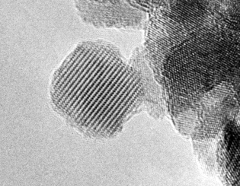 Transmission electron microscope (TEM) image of the nanoparticles
Transmission electron microscope (TEM) image of the nanoparticles
"Splitting water" may sound easy, but it is actually one of the very tricky but vital chemical reactions that take place on earth. Green plants perform it as the initial step of the process of photosynthesis. Within the process, it is responsible for the generation of molecular oxygen—upon which animals depend for energy—as well as the liberation of electrons and protons, which are then used to form hydrogen used in fuels.
Naturally, researchers dream of being able to replicate this elegant process, particularly as we seek to build a hydrogen economy, which also requires the splitting of hydrogen from water. Unfortunately, it has not turned out to be easy. Nature manages to split water at neutral pH and with very little electrical input—just the charge of photons of visible light—but artificially it typically requires very basic conditions—meaning a high pH—and a strong voltage potential.
Given that nature splits water so efficiently, one focus of scientists has been manganese, which plays a key role in the natural process of water splitting. However, they have as yet been unable to approach the efficiency of the natural process. A few years ago, however, a group of researchers discovered that manganese oxide nanoparticles arranged on an electrode could split water with much better efficiency than manganese in a bulk substance.
Now the group, led by Ki Tae Nam at Seoul National University and Ryuhei Nakamura of the RIKEN Center for Sustainable Resource Science, has analyzed the new material with a variety of techniques, including x-ray absorption near edge structure (XANES), electron paramagnetic resonance (EPR), ultraviolet–visible spectroscopy (UV-vis) and Raman spectroscopy. Through the work, they discovered that it splits water in a different way than conventional bulk materials, leading to the higher efficiency. “It turns out,” says Nakamura, “that with conventional bulk manganese catalysts, there is a first step where electrons are liberated from water, and this process hampers the efficiency of the overall reaction. We found that with the new nanoparticles, the electron is liberated along with a hydrogen ion in a single process which takes place quite efficiently. We believe that the small size of the nanoparticles may change the electronic structure of the reaction intermediates, perhaps deforming them in some way, but this will require computational work to examine exactly what is taking place.”
“It is our dream,” he continues, “to create catalysts that approach the elegance of natural processes such as photosynthesis. Work like ours is important for gaining an understanding of just how those processes work.”
According to Nam, "This work could provide important insights for understanding how the nano scale can matter in electrochemical catalysts. More broadly, it may be able to bridge a gap between natural enzymes and synthetic inorganic catalysts"
